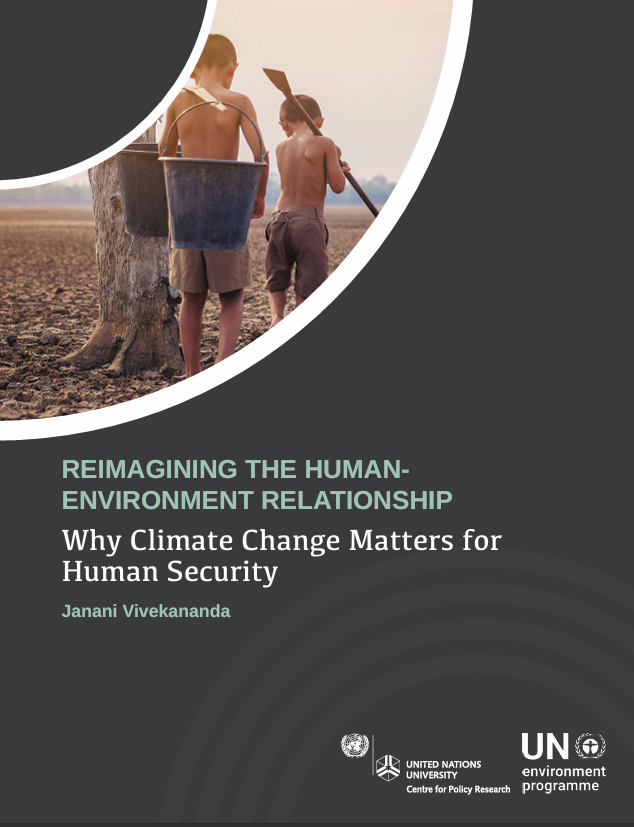This document highlights climate change’s substantial and diverse impacts on human security. It compiles substantial scientific evidence to show climate change is a “threat multiplier,” amplifying existing vulnerabilities and creating new security challenges.
In conclusion, it conducts an in-depth analysis of climate change’s global effects on human security. It encourages a coordinated approach to address these challenges, emphasizing the need for policies rooted in scientific evidence and tailored to the context to minimize negative impacts and enhance resilience to climate-related security threats.
Key Points of the Paper
- Climate Change as a Threat Multiplier: The paper emphasizes that climate change indirectly intensifies conflict by aggravating resource scarcity, affecting livelihoods, and increasing extreme weather events.
- Impact on Various Security Dimensions: Climate change effects, like altered precipitation, sea-level rise, and temperature hikes, coupled with societal and political factors, amplify conflict risks. This is especially prevalent in regions with historical conflicts, marginalization, exclusion, and poor governance.
- Comprehensive Response Required: To manage climate change security risks, a holistic approach is needed, including mitigation, system adaptation, resource management, and strengthening governance. Responses must be climate-proof and conflict-sensitive.
- Evidence-Based Policy Recommendations: The paper advocates for preventive actions considering climate and conflict risks to enhance resilience and stability in vulnerable regions. It emphasizes aligning interventions with ground realities for relevance and effectiveness.
- Global and Local Actions: The paper calls for global and local strategies to tackle climate change security implications, emphasizing policies tailored to different regions’ needs and challenges.
Overview
Introduction: Why Does Climate Change Matter for Human Security?
Underscores the view of climate change as an environmental concern and a crucial political and security issue. It stresses that climate change impacts, such as natural disasters, shifts in precipitation and temperature, coral bleaching, and sea-level rise, can greatly magnify the risk, duration, or severity of violent conflicts when combined with other factors.
The IPCC warns that climate change will heighten vulnerability and intra-state conflicts, particularly in areas with past conflict, marginalization, and poor governance. Research now focuses on understanding climate fragility risks and how such pressures can trigger conflict and fragility.
Five and a Half Pathways
Outlines the intricate connections between climate change impacts and human security. It underscores the significance of comprehending these pathways in specific contexts to guide appropriate responses and alleviate the risks of climate change and human security.
- Competition over Natural Resources: Climate-induced changes in resource access can escalate local competition, leading to conflicts, especially in fragile environments.
- Adverse Effects on Livelihoods and Human Mobility: Climate impacts can disrupt livelihoods and migration patterns, potentially straining social cohesion and increasing vulnerability to conflict.
- Conflict Risks of Climate-Related Food Price Spikes: Fluctuations in food prices due to climate events can heighten tensions and trigger conflicts, particularly in regions already facing food insecurity.
- Implications on Weak Governance Mechanisms: Climate change can exacerbate governance challenges, making it harder for institutions to manage conflicts effectively.
- Adverse Unintended Consequences of Policies: Poorly designed climate and security policies can have unintended negative consequences, further complicating the security landscape.
Pathway One
Focuses on the impact of climate change on the availability and accessibility of natural resources, potentially leading to resource conflicts. This section underlines how local contests over resources like land and water can escalate into violence, particularly in fragile environments where peaceful dispute resolution is challenging.
For example, conflicts between farmers and pastoralists in regions such as the Sahel and East Africa are highlighted. These instances demonstrate how changes in resource access due to climate can disrupt traditional practices and agreements, leading to disputes.
Conflicts stem from scarcity and changes in resource availability, heightened competition, and lack of governance and dispute resolution. Resource conflicts are often seen in historical exclusion and marginalization contexts, where existing disputes have weakened traditional resolution mechanisms.
Pathway Two
Explores the complex link between climate change, food insecurity, and conflict. It indicates that climate change may spike food prices, leading to insecurity and potentially triggering conflicts and political instability. It also suggests that food insecurity, worsened by price surges, could amplify existing conflict drivers, creating a cycle of fragility and strife.
Moreover, it’s worth mentioning that these price surges may occur in tandem with other conflict triggers, thereby further perpetuating instability. Therefore, the text underscores the need to fully understand the connection between climate-related food insecurity and conflict to address the root causes and prevent an escalation of tensions and violence.
Pathway Three
Examines the link between climate change, livelihood threats, and increased criminal activity. Emphasizes the vulnerability of natural resource-based livelihoods like agriculture and traditional grazing to climate impacts. Highlights how climate-related risks like reduced agricultural output and unsuitable grazing areas can endanger livelihoods and possibly escalate crime.
The section highlights threats to ocean resources in the Pacific and Bay of Bengal and resource disputes in Afghanistan that have escalated to violence. Understanding climate change’s impact on livelihoods and its potential to incite crime is crucial for effective strategies promoting human security.
Pathway Four
Reviews how climate-related stresses influence displacement and migration, emphasizing that these can be triggered by strained livelihoods, lack of social capacity, and absence of safety nets. It also highlights that climate change can alter migration patterns through extreme weather events, causing displacement and loss of livelihoods, prompting migration to urban areas.
Importantly, the section stresses that climate hazards increasingly trigger involuntary migration and displacement, exacerbating existing migration trends. Recognizing the influence of climate change on migration is vital in tackling displacement-related challenges and bolstering the resilience of impacted populations.
Pathway Five
Discusses how climate shocks can undermine a fragile social contract, potentially escalating tensions and conflicts. It highlights that extreme weather, intensified by climate change, can aggravate grievances if authorities’ protection or relief is perceived as inadequate, straining relations between citizens and the government.
The political effects of climate events depend on public views of the government’s capacity to support affected groups and the public’s ability to preserve social cohesion. Timely disaster relief can strengthen the citizen-state social contract but comes with potential financial risks for governments.
Pathway Five and a Half: Own Goals – Risks of Getting our Responses Wrong
Emphasizes the potential risks associated with hastily and poorly planned attempts to mitigate and adapt to climate change. It notes that while aggressive actions are necessary, these can also pose risks if not executed correctly due to possible adverse effects. The section underlines that poorly planned climate and security policies may intensify social tensions and conflict risk, hampering our response. It underlines the necessity of cautious planning and careful side effect evaluation to avoid unintended adverse outcomes, ensuring our climate strategies don’t inadvertently escalate instability or conflict.
Glass Half Empty? Underestimating the Scale and Scope of Risks
Discusses the difficulties and limitations in accurately assessing climate change’s security impacts. Remarkably, it notes that despite the significant expansion of quantitative scientific literature on this subject, there is a risk of underestimating the extent and reach of climate fragility risks.
Existing studies have mainly focused on areas like Africa and rural settings, neglecting other vulnerable regions such as the Pacific, South Asia, and South America. Moreover, these studies do not adequately represent urban areas, which encounter distinct climate change challenges.
In light of this, the section underscores the need for a more inclusive and comprehensive approach to studying climate-fragility risks. Ultimately, this will help to understand and address the intricate relationship between climate change and human security on a global level.
What Needs to be Done?
Emphasizes addressing climate fragility risks for human security and peace. Recommends thorough risk assessments considering the link between climate change, conflict, and security. Suggests including climate data in conflict early warning systems for informed decision-making and quick action. Advocates for improved capacity and resources for effective climate-security risk integration into policy and programs.
Understanding and mitigating the causes of climate change vulnerability, including livelihood diversification, political marginalization, and unsustainable resource management, is emphasized. The need for a comprehensive approach to multiple dimensions of climate fragility risks, crucial for building resilience and promoting sustainable development, is also underlined.
Conclusion
The document highlights the importance of viewing climate change as a vital human security issue, linking it to conflict and security. It stresses the need for thorough risk assessments and coordinated responses. The conclusion emphasizes bridging the research-policy gap for effective decision-making. It advocates for localized risk assessments and tailored responses, proposes including climate data in early warning systems, and stresses the need to proactively manage climate-fragility risks to enhance resilience in a volatile climate scenario.
Henceforth. Moreover. Furthermore. Nonetheless. Nevertheless.




